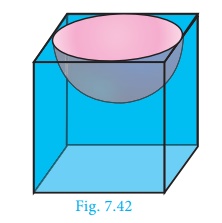Solved Example Problems | Mensuration | Mathematics - Volume and Surface Area of Combined Solids | 10th Mathematics : UNIT 7 : Mensuration
Chapter: 10th Mathematics : UNIT 7 : Mensuration
Volume and Surface Area of Combined Solids
Volume and Surface Area of Combined Solids
Observe the shapes given (Fig.7.37).

The shapes provided lead to the
following definitions of ‘Combined Solid’.
A combined solid is said to be a solid formed by combining two or
more solids.
The concept of
combined solids is useful
in the fields like doll making, building construction, carpentry, etc.
To calculate the surface area of the combined solid, we should
only calculate the areas that are visible to our eyes. For example, if a cone
is surmounted by a hemisphere, we need to just find out the C.S.A. of the
hemisphere and C.S.A. of the cone separately and add them together. Note that
we are leaving the base area of both the cone and the hemisphere since both the
bases are attached together and are not visible.
But, the volume of the solid formed by joining two basic solids
will be the sum of the volumes of the individual solids.
Example 7.24
A toy is in the shape of a cylinder surmounted by a hemisphere.
The height of the toy is 25 cm. Find the total surface area of the toy if its
common diameter is 12 cm.
Solution
Let r and h be the radius and height of the cylinder respectively.
Given that, diameter d = 12 cm, radius r = 6 cm

Total height of the toy is 25 cm
Therefore, height of the cylindrical portion = 25 − 6 = 19 cm
T.S.A. of the toy = C.S.A. of the cylinder + C.S.A. of the
hemisphere +Base Area of the cylinder
= 2πrh + 2πr 2 + πr 2
= πr (2h + 3r) sq. units
= (22/7) × 6 × (38 + 18)
= (22/7) × 6 ×56 = 1056
Therefore, T.S.A. of the toy is 1056 cm2
Example 7.25
A jewel box (Fig. 7.39) is in the shape of a cuboid of dimensions
30 cm × 15 cm ×10 cm surmounted by a half part of a cylinder as shown in the
figure. Find the volume and T.S.A. of the box.

Solution
Let l, b and h1 be the length, breadth and height of the cuboid. Also let us take r
and h2 be the radius and height of the cylinder.
Now, Volume of the box = Volume of the cuboid + 1/2 (Volume
of cylinder)

= 4500 + 2651. 79 = 7151. 79
Therefore, Volume of the box = 7151.79 cm3
Now, T.S.A. of the box = C.S.A. of the cuboid+ 1/2 (C.S.A. of the
cylinder)

= 900 + 707. 14 = 1607. 14
Therefore, T.S.A. of the box = 1607. 14 cm2
Example 7.26 Arul has to make arrangements for the
accommodation of 150 persons for his family function. For this purpose, he plans to build a
tent which is in the shape of cylinder surmounted by a cone. Each person
occupies 4 sq. m of the space on ground and 40 cu. meter of air to breathe.
What should be the height of the conical part of the tent if the height of
cylindrical part is 8 m?
Solution
Let h1 and h2 be the height of cylinder and cone respectively.
Area for one person = 4 sq. m
Total number of persons = 150

Therefore total base area = 150×4
πr2 = 600

Volume of air required for 1 person = 40 m3
Total Volume of air required for 150 persons = 150 ×40 = 6000 m3

Therefore, the height of the conical tent h2
is 6 m
Example 7.27 A funnel consists of a frustum of a cone attached
to a cylindrical portion 12 cm long attached at the bottom. If the total height be 20 cm,
diameter of the cylindrical portion be 12 cm and the diameter of the top of the
funnel be 24 cm. Find the outer surface area of the funnel.
Solution
Let R, r be the top and bottom radii of the frustum.
Let h1, h2 be the
heights of the frustum and cylinder respectively.
Given that, R = 12 cm, r = 6 cm, h2
= 12 cm

Now, h1 = 20–12 = 8 cm
Here, Slant height of the frustum l

l = 10 cm
Outer surface area = 2πrh2 + π (R + r )l
sq. units
= π [2rh2 + (R + r )l]
= π [ (2 × 6 ×12) + (18 ×10)]
= π [144 + 180]
= (22/7) ×324 = 1018.28
Therefore, outer surface area of the funnel is 1018.28 cm2
Example 7.28
A hemispherical section is cut out from one face of cubical block
(Fig.7.42) such that the diameter l of the hemisphere is equal to side
length of the cube. Determine the surface area of the remaining solid.

Solution
Let r be the radius of the hemisphere.
Given that, diameter of the hemisphere = side of the cube = l
Radius of the hemisphere = l/2
TSA of the remaining solid = Surface area of the cubical part + C.S.A.
of the hemispherical part − Area of the base
of the hemispherical part
= 6 ×(Edge)2 + 2πr2 − πr2
= 6 ×(Edge)2 + πr2

Total surface area of the remaining solid = 1/4 (24 + π)l2 sq. units
Related Topics